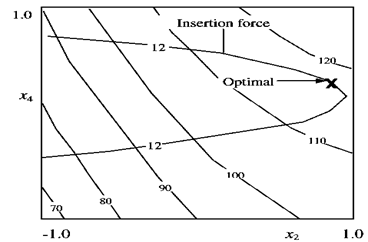SKEDSOFT
Example(Snap Tab Formal Optimization): Suppose a design team is charged with evaluating whether plastic snap tabs can withstand high enough pull-apart force to replace screws. Designers can manipulate design inputs x1, x2, x3, and x4 over allowable ranges –1.0 to 1.0. These inputs are dimensions of the design in scaled units. Also, a requirement is that each snap tab should require less than 12 pounds (386 N). From RSM, the following models are available for pull-apart force (yest,1) and insertion force (y est,2) in pounds:
Formulate the relevant optimization problem and solve it.
Answer: The optimization formulation is:
A plot of the objective contours and the insertion force constraint for the snap tab optimization example. Note that dependence of objectives and constraints can only be plotted as a function of two input factors in this way. The plot shows that a conflict exists between the goals of increasing pull-apart forces and decreasing insertion forces.


- An important concern with applying formal optimization is that information requirements are often such that all relevant considerations cannot be included in the formulation. For example, in the restaurant problem there was no obvious way to include into the formulation information about the overall strategy to raise prices.
- On the other hand, the information requirements of applying formal optimization can be an advantage. They can force people from different areas in the organization to agree on the relevant assumptions and problem data. This exercise can encourage communication that may be extremely valuable.
- One way to account for additional considerations is to add constraints to formulations. These added constraints can force the optimization solver to avoid solutions that are undesirable because of considerations not included in the formulation. In general, some degree of informality is needed in translating solver results into recommended design inputs.
